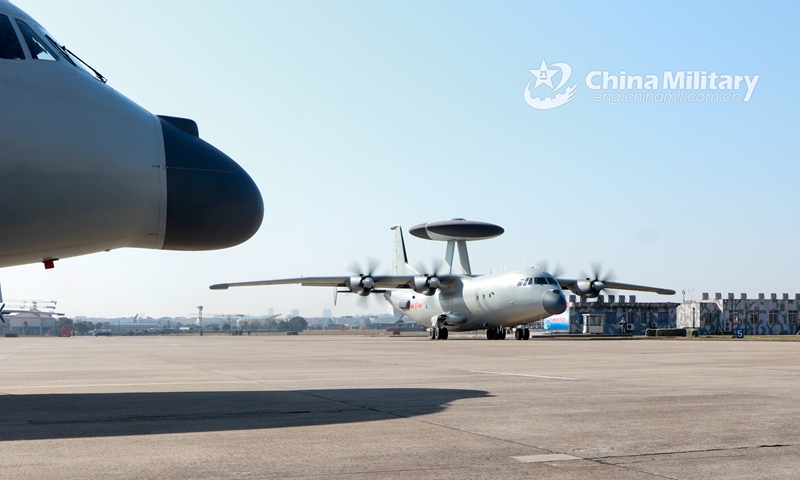
A KJ-500 airborne early warning (AEW) aircraft attached to a naval aviation division under the PLA Eastern Theater Command taxis onto the flightline in preparation for a flight training exercise on subjects including reconnaissance and early warning, anti-submarine tactics, etc. on February 20, 2021. (Photo: Xinhua)
A future airborne warning and control system (AWACS) will likely not be one single early warning aircraft, but a cluster of platforms that can accomplish different missions and build an information network, said chief designers of China's early warning aircraft this week.
The development trend of the world's most advanced AWACS has two aspects, namely the capability of an individual aircraft and the system, Lu Jun, chief designer of China's KJ-2000 early warning aircraft, said in a seminar organized by xinhuanet.com, the website of the Xinhua News Agency, on Tuesday.
For individual aircraft, they will be more capable of dealing with small targets, stealth aircraft and drones, said Lu, also an academician at the Chinese Academy of Engineering.
But war is not about just an individual aircraft, but a system, so there should be space, aerial, ground, maritime and underwater platforms integrated together and doing their job, Lu said, noting that this will enhance the joint combat capability based on an information network system.
The fast-developing military intelligentization will also contribute to the development of AWACS, Lu said.
Cui Jixian, the executive deputy designer of China's KJ-500 early warning aircraft and the chief designer of country's next generation AWCAS, said at the seminar that future AWACS will definitely become an information network system that includes not only one single aircraft, but a cluster of platforms that can either operate together or alone.
These platforms will play their specially designed roles based on the demands of combat missions, with the final goal being winning the war, Cui said, noting that both large and small AWCAS platforms are future trends.
Some military observers and analysts have been discussing whether larger platforms like the KJ-2000 or smaller platforms like the KJ-500 or even drones are better candidates for future AWACS development, but the two chief designers' remarks indicate that both types could be developed, a Chinese military expert told the Global Times on Thursday, requesting anonymity.
The KJ-2000 was developed based on the Russian 190 ton-class Il-76 large transport aircraft, and the KJ-500 is derived from the domestically made 60 ton-class Y-8 medium-sized transport aircraft.
The Y-20 large transport aircraft is a good platform to spawn an early warning variant, and completely new platforms could be in the works, the expert said.
When talking about the capabilities of China's AWACS, Lu said that the KJ-2000, China's first operational AWACS, is one full generation ahead of the US' E-3C AWACS and E-2C Hawkeye thanks to its phased array radar technology, citing a commentary by the US-based Jamestown Foundation in 2010.
The KJ-500 is another generation ahead of the KJ-2000, meaning that China's AWACS is now leading the US ones by two generations, Lu said.




